Archive
- Behind the Screens 9
- Bright Young Things 16
- Colour Palette 64
- Dress Ups 60
- Fashionisms 25
- Fashionistamatics 107
- Foreign Exchange 13
- From the Pages of… 81
- G.U.I.L.T. 10
- Little Trifles 126
- Lost and Found 89
- Odd Socks 130
- Out of the Album 39
- Red Carpet 3
- Silver Screen Style 33
- Sit Like a Lady! 29
- Spin, Flip, Click 34
- Vintage Rescue 20
- Vintage Style 157
- Wardrobe 101 148
- What I Actually Wore 163
What I Actually Wore #0158
 Serial #: 0158
Serial #: 0158
Date: 21/12/2013
Weather: 20°C / 68°F
Time Allowed: 8 minutes
Wide-leg pants with a fun top and colourful accessories are, and forever will be, a staple silhouette for me (in fact I am wearing a version of this ensemble right now as I type). I wore this outfit to work, and then made only minimal changes to my outfit before going to see a play with a friend in the evening.
I no longer own the pants; they were a bit big to start with, and eventually they became too big when I lost a bit of weight. (You know your pants are too big when you can slip them off without undoing the zip!) The blouse is still with me, as are all the other items except for both pairs of shoes. The tan brogued sandals are among the most favourite I have ever owned, but sadly they completely wore out and I had to bin them.
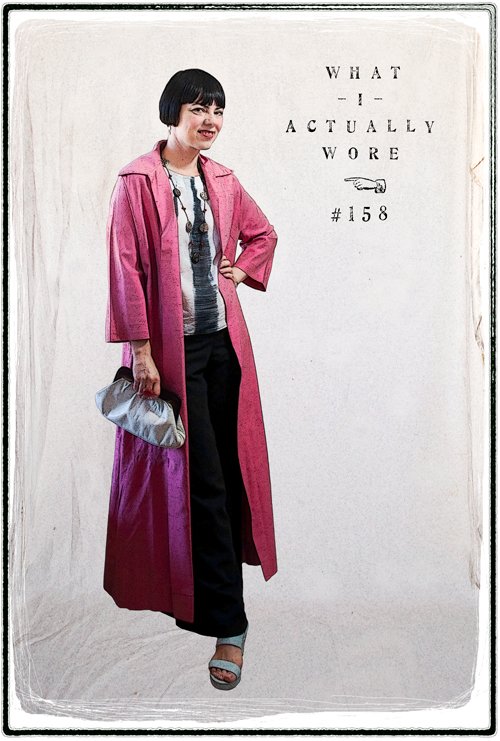 During the day, I wore a vintage 1950s silk cropped jacket in a beautiful shade of blue, and in the evening swapped it for an evening coat of pink slubbed silk or rayon. I love the drama of its maxi length. I walked into the city to the theatre, and chose comfortable leather platform wedges – although the leather of these was so soft they stretched out and became too big as well, and impossible to walk in. I ended up giving them to a friend.
During the day, I wore a vintage 1950s silk cropped jacket in a beautiful shade of blue, and in the evening swapped it for an evening coat of pink slubbed silk or rayon. I love the drama of its maxi length. I walked into the city to the theatre, and chose comfortable leather platform wedges – although the leather of these was so soft they stretched out and became too big as well, and impossible to walk in. I ended up giving them to a friend.
The ceramic jewellery I am wearing is all souvenired from Barcelona. The necklace and earrings have become a bit lost amongst my huge collection of costume jewellery, but I regularly wear the ring, and its companion, a ceramic cluster of green balls. I thought they were great mementoes of the city that Gaudí made particularly his own.
I still remember buying that leather clutch bag with its plastic tortoiseshell frame – maybe 15 or more years ago now – from a vintage boutique that is no longer, in a street that is also no longer what it was, having become gentrified, near my old art college, which also is no longer, having closed down many years ago and subsequently was torn down! What a litany of closures, and memories they conjure up.
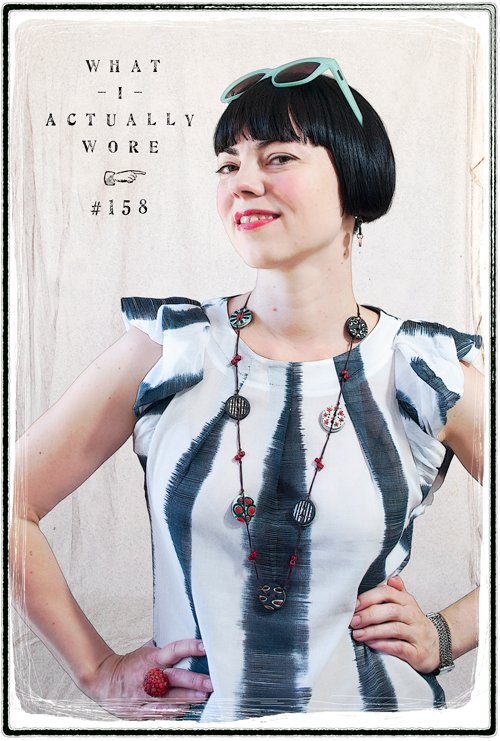 I still visit that neighbourhood, and marvel at how much it’s changed, and smile nostalgically at what is still the same. That vintage boutique was the last hold-out of a large number in that cool street (hipster before hipsters existed) that all gradually closed down, sadly, and it was a really good one. I also remember buying there a fantastic pair of vintage 1970s pink metallic kid leather high-heeled strappy sandals by Christian Dior that were a size too small for me for about $15. It hurt to wear them, but … CHRISTIAN DIOR. One day, in a ruthless fit, I donated them to a charity store. No regrets. I since found a pair of silver patent Christian Louboutins for $4 IN my size. Thou givest to the charity store, and the charity store givest back to thee.
I still visit that neighbourhood, and marvel at how much it’s changed, and smile nostalgically at what is still the same. That vintage boutique was the last hold-out of a large number in that cool street (hipster before hipsters existed) that all gradually closed down, sadly, and it was a really good one. I also remember buying there a fantastic pair of vintage 1970s pink metallic kid leather high-heeled strappy sandals by Christian Dior that were a size too small for me for about $15. It hurt to wear them, but … CHRISTIAN DIOR. One day, in a ruthless fit, I donated them to a charity store. No regrets. I since found a pair of silver patent Christian Louboutins for $4 IN my size. Thou givest to the charity store, and the charity store givest back to thee.
Items:
Blouse: Veronika Maine
Jacket (am): vintage 50s
Coat (pm): vintage 50s
Pants: Dizingoff
Sunglasses: MinkPink
Bag: vintage 70s
Sandals (am): Wittner
Wedges (pm): RMK
Earrings: souvenir
Necklace: souvenir
Watch: Kenneth Cole
Ring: souvenir
Photos: January 2014
Strong and Bold
 In honour of the Australian Rules Football Grand Final match today, I bring you this yellow and black vintage 1950s dress, in the team colours of the Richmond Football Club, a club that has been running for more than a century. They are playing Greater Western Sydney Giants; in contrast, a modern team formed only a decade ago, whose colours are a rather odd combination of orange, black and white.
In honour of the Australian Rules Football Grand Final match today, I bring you this yellow and black vintage 1950s dress, in the team colours of the Richmond Football Club, a club that has been running for more than a century. They are playing Greater Western Sydney Giants; in contrast, a modern team formed only a decade ago, whose colours are a rather odd combination of orange, black and white.
I don’t barrack for (that’s Aussie for ‘follow’) Richmond except for today, although I live next door to the inner-city suburb in which it was formed, and in fact Richmond East is my local stomping ground.
This is an outfit I wore in the summer of this year, with a 1950s cello hat, a 1960s bag, and modern patent shoes and belt. Richmond’s club mascot is a tiger, and I’m rather pleased the way this dress emulates a tiger’s claw slashes … if a tiger had decided to dip its claws in black paint and do some textile design! Previously I’d thought the pattern reminded me of the grasses of an African savanna, which is also apt.
Today I shall finish with Richmond’s club song:
Oh we're from Tigerland
A fighting fury
We're from Tigerland
In any weather you will see us with a grin
Risking head and shin
If we're behind then never mind
We'll fight and fight and win
For we're from Tigerland
We never weaken til the final siren's gone
Like the Tiger of old
We're strong and we're bold
For we're from Tiger
Yellow and Black
We're from Tigerland.
Go Tiges! Oops, the game is starting, bye!
Photo: April 2019
Marvellous Mauve
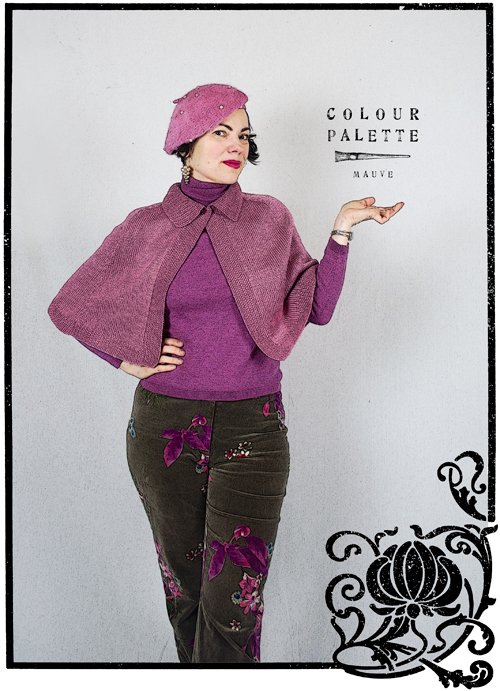 A couple of years ago I wrote a story about different shades of purple, and I touched on the discovery of the first aniline dye in 1856 that became known as mauve, the French word for mallow flower after which the colour is named. Originally it was probably a darker shade than contemporary notions of it, as it was first likened to Tyrian purple which is much darker. The first mauve dye was replaced with other synthetic dyes in 1873: a lighter, less-saturated shade that we are familiar with today. As Wikipedia succinctly describes it, ‘mauve contains more grey and more blue than a pale tint of magenta’.
A couple of years ago I wrote a story about different shades of purple, and I touched on the discovery of the first aniline dye in 1856 that became known as mauve, the French word for mallow flower after which the colour is named. Originally it was probably a darker shade than contemporary notions of it, as it was first likened to Tyrian purple which is much darker. The first mauve dye was replaced with other synthetic dyes in 1873: a lighter, less-saturated shade that we are familiar with today. As Wikipedia succinctly describes it, ‘mauve contains more grey and more blue than a pale tint of magenta’.
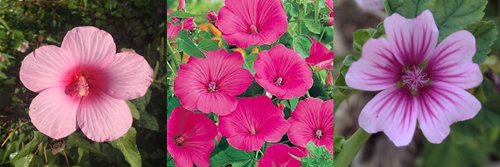 Three shades of mallow flowersHowever, while it was a synthetic dye, in the 1850s it was still quite expensive to process, and if not for Empress Eugénie, wife of Napoleon III, taking a liking to it because it supposedly exactly matched her ‘violet’ eyes, the colour might have disappeared. Queen Victoria subsequently gave it the thumbs-up, and for a time it was all the rage, reaching its heights of popularity in the 1890s.
Three shades of mallow flowersHowever, while it was a synthetic dye, in the 1850s it was still quite expensive to process, and if not for Empress Eugénie, wife of Napoleon III, taking a liking to it because it supposedly exactly matched her ‘violet’ eyes, the colour might have disappeared. Queen Victoria subsequently gave it the thumbs-up, and for a time it was all the rage, reaching its heights of popularity in the 1890s.
… for a time it was all the rage, reaching its heights of popularity in the 1890s
As with many trends, however, it soon reached over-saturation in the market and eventually it became passé, synonymous with ladies of a certain age. Even in the twentieth century, it was associated with aging, as it was one of the shades white-haired ladies chose to rinse their hair with to remove unlikable yellowish tones. Today of course that trend has been turned on its head and grey hair tinted with pastel shades is all the rage with young people!
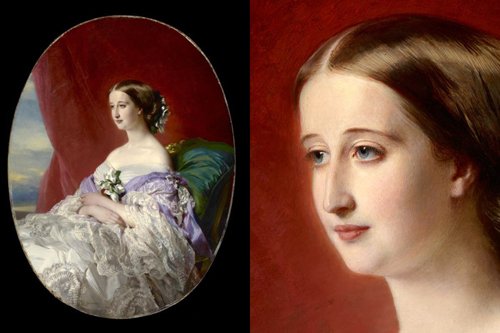 Empress Eugenie, 1854, by Franz Xaver Winterhalter – Franz clearly thought, "Pfft, purple eyes, MY EYE!"
Empress Eugenie, 1854, by Franz Xaver Winterhalter – Franz clearly thought, "Pfft, purple eyes, MY EYE!"
Wait, what about the purple eyes?
I was interested in this notion of the Empress’s supposed violet eyes, and some research lead me to learn that Elizabeth Taylor was another celebrity famed for her violet eyes. Paintings are not necessarily true to life, and photographic evidence is obviously unreliable as it is too easy to digitally enhance hues or use colour filters in-camera.
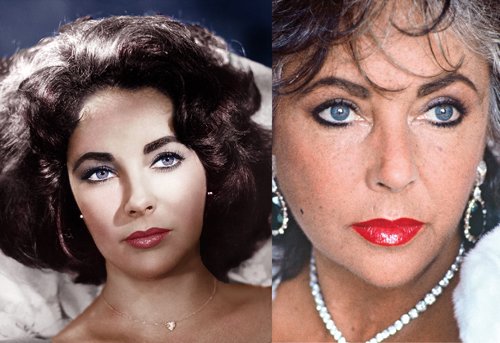 Elizabeth Taylor in 1960 (ph unknown) and 1985 (ph Helmut Newton); she definitely seems to have naturally blue eyes that have been enhanced by the colour processing in the first photoAfter a lot of reading, I can state definitely that the human eye does not naturally come in shades of purple; ie people cannot be born with it. Put simply, the colour of an iris changes depending on how much light reaches it, and can be enhanced by coloured clothing or makeup surrounding the eyes; both Empress Eugénie and Elizabeth Taylor had blue eyes: one wore purple garments, the other purple eyeshadow. [See Further Reading below]
Elizabeth Taylor in 1960 (ph unknown) and 1985 (ph Helmut Newton); she definitely seems to have naturally blue eyes that have been enhanced by the colour processing in the first photoAfter a lot of reading, I can state definitely that the human eye does not naturally come in shades of purple; ie people cannot be born with it. Put simply, the colour of an iris changes depending on how much light reaches it, and can be enhanced by coloured clothing or makeup surrounding the eyes; both Empress Eugénie and Elizabeth Taylor had blue eyes: one wore purple garments, the other purple eyeshadow. [See Further Reading below]

Back to fashion …
Since my original story, I have since found new mauve items in differing shades all from thrift stores: a merino wool jumper, a prettily hand-knitted vintage wool cape, and a vintage angora, pearl-beaded beret. The jumper is modern, but I am not sure of the age of the latter two; the beret was missing pearls when I bought it, but the cape is pristine and could be a modern knit made using a vintage pattern. My printed velvet pants are modern, by the Australian label Charlie Brown.
Scroll down and check out some more mauve outfits from the Victorian era to the present.
Further Reading
The biology behind eye colour in humans
Were Elizabeth Taylor’s eyes really violet?
But wait, Liz Taylor had double eyelashes!
Just how did Lizzie make her blue eyes look purple?
Photos: August 2019
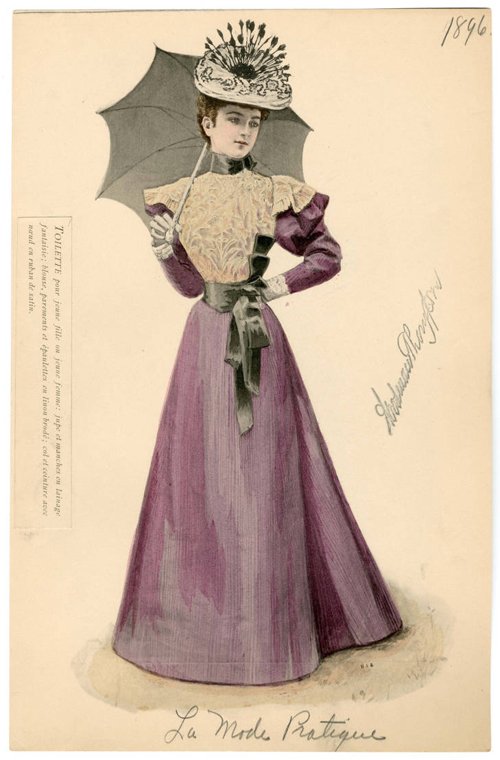 Victorian walking dress, 1896
Victorian walking dress, 1896 Victorian evening dress, 1896
Victorian evening dress, 1896 Victorian silk striped walking dress
Victorian silk striped walking dress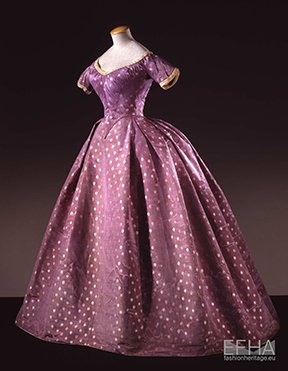 Silk taffeta evening dress, 1860-1865
Silk taffeta evening dress, 1860-1865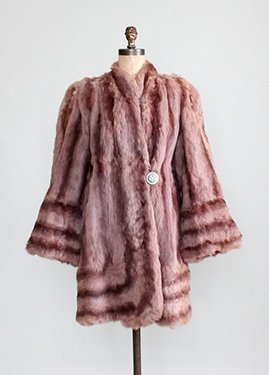 1930s fur jacket (sold)
1930s fur jacket (sold) 1930s bias gown (for sale)
1930s bias gown (for sale) 1940s catalogue – how I would love to buy this set, especially at those prices!
1940s catalogue – how I would love to buy this set, especially at those prices! Model Evelyn Tripp, wearing a dress and matching hat, ph Frances McLaughlin-Gill for Vogue
Model Evelyn Tripp, wearing a dress and matching hat, ph Frances McLaughlin-Gill for Vogue Modern outfit
Modern outfit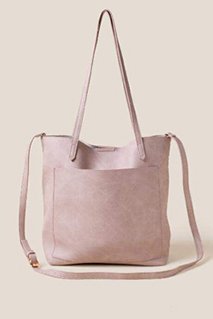 Rosie tote in mauve
Rosie tote in mauve
The Luxury Hat
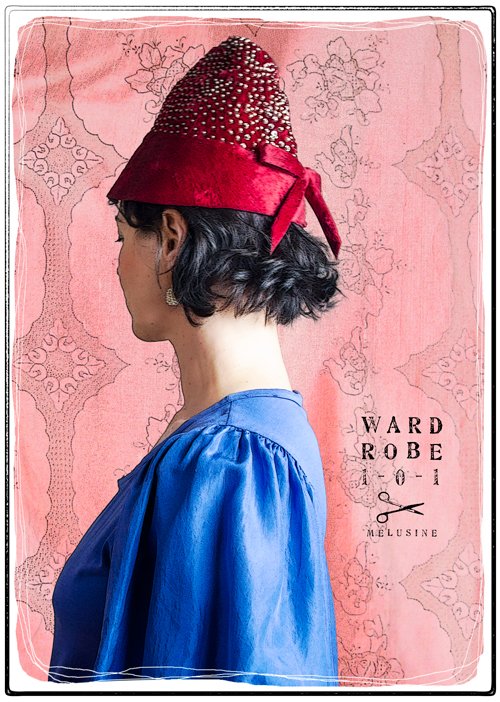 Felt is an ancient fabric, and perhaps the first made by man: it is made rather easily as it is not woven and does not require a loom. According to legend, in the Middle Ages a wandering monk named St Clement – destined to become the fourth bishop of Rome – happened upon the process of felt-making quite by accident. It is said that to make his shoes more comfortable, he stuffed them with tow (short flax or linen fibres). Walking in them on damp ground, he discovered that his own weight and sweaty feet had matted the tow fibres together into a kind of cloth. After being made bishop (with the power to indulge his whimsy), he set up a workshop to develop felting production … and thus he became the patron saint for hatmakers, who of course use felt to this day.
Felt is an ancient fabric, and perhaps the first made by man: it is made rather easily as it is not woven and does not require a loom. According to legend, in the Middle Ages a wandering monk named St Clement – destined to become the fourth bishop of Rome – happened upon the process of felt-making quite by accident. It is said that to make his shoes more comfortable, he stuffed them with tow (short flax or linen fibres). Walking in them on damp ground, he discovered that his own weight and sweaty feet had matted the tow fibres together into a kind of cloth. After being made bishop (with the power to indulge his whimsy), he set up a workshop to develop felting production … and thus he became the patron saint for hatmakers, who of course use felt to this day.
 Parisian costume, 1826
Parisian costume, 1826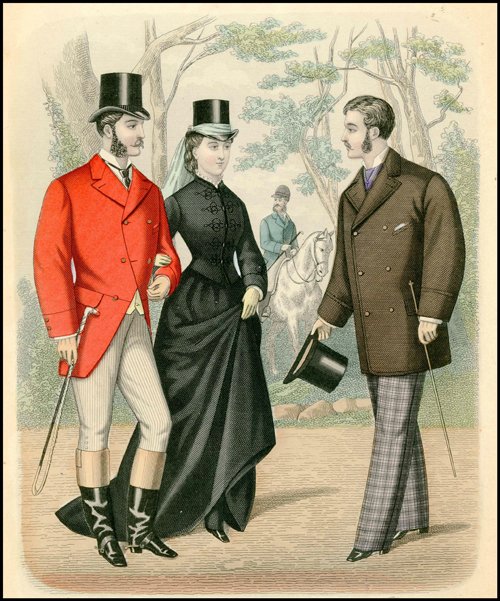 Men and women’s beaver top hats, Gentleman’s Magazine of Fashion, 1876Today most felt is made of wool, but in the past, animal fur was used to make a high-quality felt. Animal fur has tiny, microscopic spines which lock together much like Velcro when heat and moisture are applied. Beaver was the superior fur because its spines were prominent and helped produce a high-quality felt; hats made from it date back to at least the sixteenth century, and they were a staggeringly expensive luxury item. Naturally, to reduce the cost of fur felt, other furs were used such as rabbit or hare, camel, and angora (mohair).
Men and women’s beaver top hats, Gentleman’s Magazine of Fashion, 1876Today most felt is made of wool, but in the past, animal fur was used to make a high-quality felt. Animal fur has tiny, microscopic spines which lock together much like Velcro when heat and moisture are applied. Beaver was the superior fur because its spines were prominent and helped produce a high-quality felt; hats made from it date back to at least the sixteenth century, and they were a staggeringly expensive luxury item. Naturally, to reduce the cost of fur felt, other furs were used such as rabbit or hare, camel, and angora (mohair).
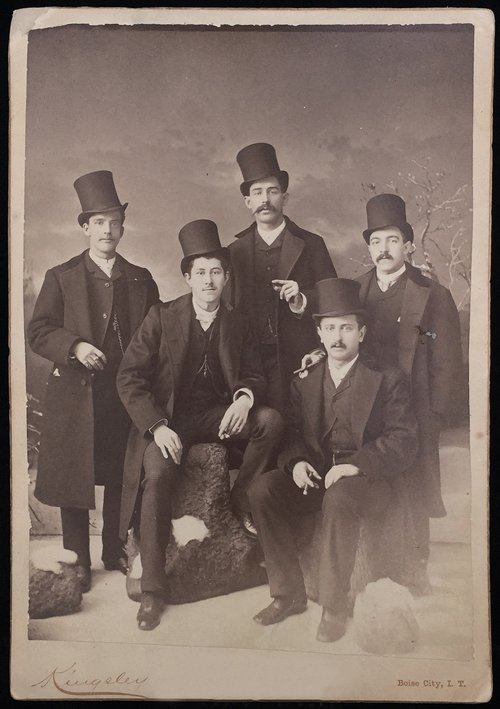 Men wearing beaver hats, 1886But it was another type of hat altogether that toppled the beaver from its luxury perch at last: the silk top hat. First invented in 1797 and scandalising the general public with its fearsome appearance, by the mid nineteenth century, the silk top hat cost half the price of beaver, and overtook it in popularity owing to changes in lifestyle which meant the hardy fur felt hats were not needed.
Men wearing beaver hats, 1886But it was another type of hat altogether that toppled the beaver from its luxury perch at last: the silk top hat. First invented in 1797 and scandalising the general public with its fearsome appearance, by the mid nineteenth century, the silk top hat cost half the price of beaver, and overtook it in popularity owing to changes in lifestyle which meant the hardy fur felt hats were not needed.
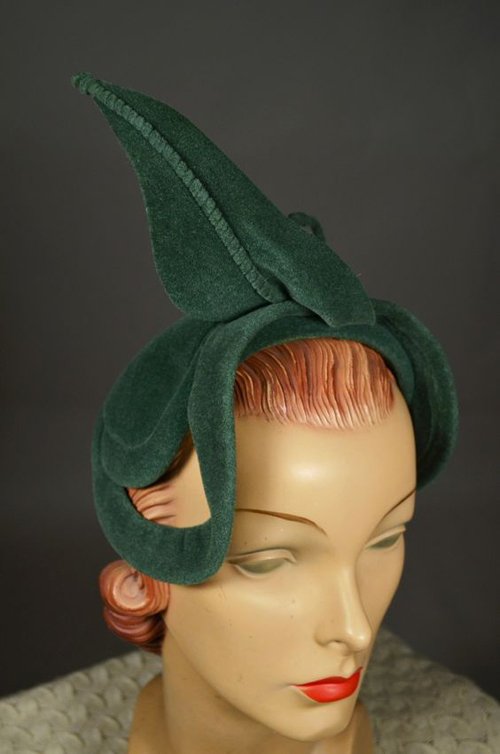 50s hat of angora fur felt; authorised reproduction of a Claude Saint-Cyr designI was initially attracted to this red 1950s pixie hat because of its dramatic shape, and the pearls (which I love) sewn all over it. It is made with Melusine, a felt made from rabbit fur. Melusine has long, fine fibres that are brushed to create a silky long-haired finish. In the past I had presumed ‘fur felt’ was a misnomer, and that such fabric was actually made from wool to look like fur. I was a bit sad when I realised this hat was real rabbit fur; however, at least it is vintage and recycled.
50s hat of angora fur felt; authorised reproduction of a Claude Saint-Cyr designI was initially attracted to this red 1950s pixie hat because of its dramatic shape, and the pearls (which I love) sewn all over it. It is made with Melusine, a felt made from rabbit fur. Melusine has long, fine fibres that are brushed to create a silky long-haired finish. In the past I had presumed ‘fur felt’ was a misnomer, and that such fabric was actually made from wool to look like fur. I was a bit sad when I realised this hat was real rabbit fur; however, at least it is vintage and recycled.
 An amazing pink fur felt reproduction Regency hat, by Jane Walton, 2019I have a few other vintage hats also made from melusine, all from the 50s and 60s. While wool felt is certainly more common these days, you can still buy new fur felt hats (some sources nebulously state the fur is a ‘by-product’) – even top hats made from beaver that are worn by top cats at Ascot – and they are still quite expensive.
An amazing pink fur felt reproduction Regency hat, by Jane Walton, 2019I have a few other vintage hats also made from melusine, all from the 50s and 60s. While wool felt is certainly more common these days, you can still buy new fur felt hats (some sources nebulously state the fur is a ‘by-product’) – even top hats made from beaver that are worn by top cats at Ascot – and they are still quite expensive.
Photo: June 2019
Sweater Clips DIY
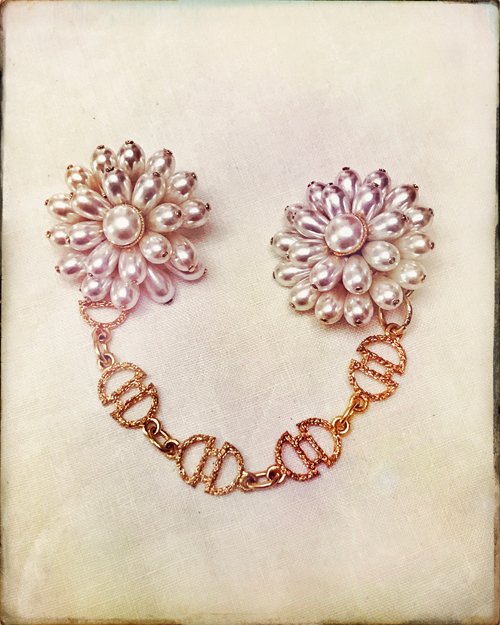 I have always wanted a pair of sweater clips, for those times you want to draw your cardigan close, but not button it up, or for those garments that do not have closures, such as vintage 50s outerwear. I’ve searched in thrift stores to no avail, for they are an item one just does not see in Australia. Maybe they simply were never a popular fashion accessory here. I have searched online of course, but with such high shipping costs (when buying from America in particular), they became ridiculously expensive.
I have always wanted a pair of sweater clips, for those times you want to draw your cardigan close, but not button it up, or for those garments that do not have closures, such as vintage 50s outerwear. I’ve searched in thrift stores to no avail, for they are an item one just does not see in Australia. Maybe they simply were never a popular fashion accessory here. I have searched online of course, but with such high shipping costs (when buying from America in particular), they became ridiculously expensive.
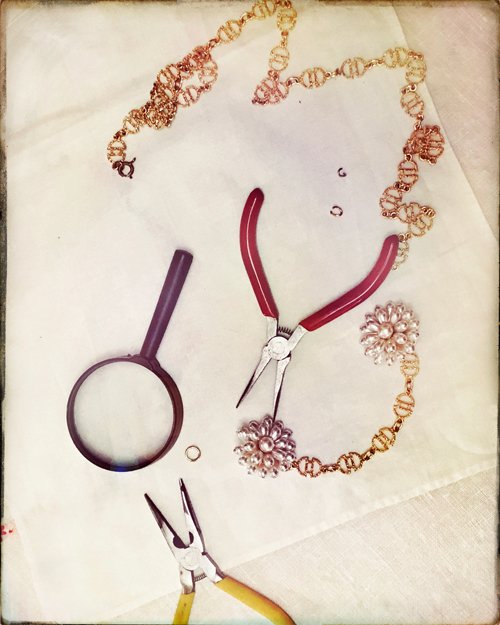 So I decided to make my own. First I found a pair of giant 1980s pearl clip on earrings. Then I scoured op shops for a suitable chain. And I waited patiently. And I scoured some more. Finally I found a gold necklace that had a more interesting chain than the usual link. I already had some suitable gold findings from a previous repair, and at last I set to work with some jewellery tools.
So I decided to make my own. First I found a pair of giant 1980s pearl clip on earrings. Then I scoured op shops for a suitable chain. And I waited patiently. And I scoured some more. Finally I found a gold necklace that had a more interesting chain than the usual link. I already had some suitable gold findings from a previous repair, and at last I set to work with some jewellery tools.
I’m really pleased with the result. It’s been a very mild autumn in Melbourne and I’ve yet to break out my vintage cardigans, so I am looking forward to using the clips now that the weather is finally becoming cooler.


